乔姆斯基语言观
语言学名著导读课件乔姆斯基的语言观

基础部分 语类 词库
D- ove a
LF 逻辑表达式
PF 语音形式表达式
6. 第六阶段1993:最简方案 (Minimalist Program:MP)
三个充分
1. 观察充分性 :最低标准。 2. 描写充分性 :较高的标准 3. 解释充分性 :最高标准
乔姆斯基的影响
小结
“不论功与过,对与错,乔姆斯基的语法理论 无疑是最有活力最有影响力的;任何一个语 言学家,只要他不愿在自己的学科中落伍, 都不敢漠视乔姆斯基的理论。现今每一个其 他“流派”的语言学都要以乔姆斯基在某些 问题上的观点为参照来界定自己的地位。”
----------Lyons
一、心理学
他的普遍语法理论被很多人认为是对既 定的行为主义理论的直接挑战。这一理 论对于理解儿童如何习得语言以及什么 是真正理解语言的能力都有深远的意义。
如: 1959年乔姆斯基出版了对斯金纳 的《口头行为》一书的长篇评论。开 创了美国心理学从二十世纪五十年代 到七十年代的「认知革命」,也就是 从以行为研究为主转变为认知研究为 主。
N
The boy hit the ball
缺点:生成语法合格但语义不对的句子
*Colorless green ideas sleep furiously *(无色的绿色的思想疯狂地睡觉)
*足球踢男孩。 *吃三角形。
*不想当裁缝的厨子不是好司机 。
2. 第二阶段1965:标准理论(Standard Theory,简称:ST)
每个词的特征在词库中做了详细说明。一个词 只有满足了短语结构规则中对特征的说明时, 才有被插入的可能,以保证能生成正确的、可 接受的句子,而不会生成 Colorless green ideas sleep furiously. 但要能做到这一点, 要做的工作实在是太多。
乔姆斯基语言观与中国语言的关系
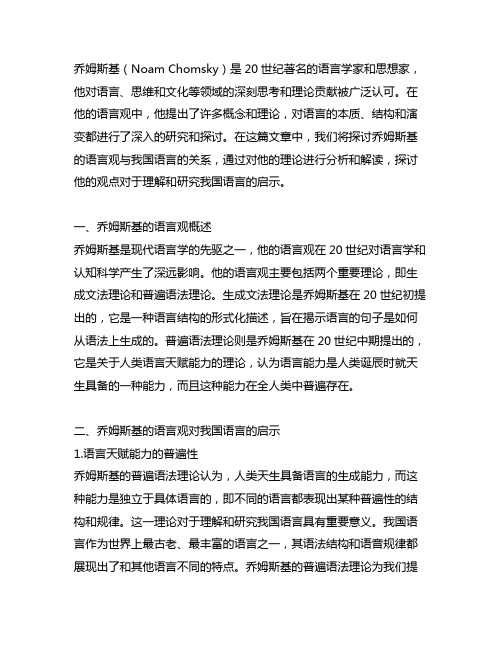
乔姆斯基(Noam Chomsky)是20世纪著名的语言学家和思想家,他对语言、思维和文化等领域的深刻思考和理论贡献被广泛认可。
在他的语言观中,他提出了许多概念和理论,对语言的本质、结构和演变都进行了深入的研究和探讨。
在这篇文章中,我们将探讨乔姆斯基的语言观与我国语言的关系,通过对他的理论进行分析和解读,探讨他的观点对于理解和研究我国语言的启示。
一、乔姆斯基的语言观概述乔姆斯基是现代语言学的先驱之一,他的语言观在20世纪对语言学和认知科学产生了深远影响。
他的语言观主要包括两个重要理论,即生成文法理论和普遍语法理论。
生成文法理论是乔姆斯基在20世纪初提出的,它是一种语言结构的形式化描述,旨在揭示语言的句子是如何从语法上生成的。
普遍语法理论则是乔姆斯基在20世纪中期提出的,它是关于人类语言天赋能力的理论,认为语言能力是人类诞辰时就天生具备的一种能力,而且这种能力在全人类中普遍存在。
二、乔姆斯基的语言观对我国语言的启示1.语言天赋能力的普遍性乔姆斯基的普遍语法理论认为,人类天生具备语言的生成能力,而这种能力是独立于具体语言的,即不同的语言都表现出某种普遍性的结构和规律。
这一理论对于理解和研究我国语言具有重要意义。
我国语言作为世界上最古老、最丰富的语言之一,其语法结构和语音规律都展现出了和其他语言不同的特点。
乔姆斯基的普遍语法理论为我们提供了一个全新的视角,即在研究我国语言时,我们应该看到其独特之处,但同时也注意到其中蕴含的普适性规律。
2.语言的生成过程生成文法理论主张,语言的结构可以通过一种生成的过程来解释和描述。
这种生成的过程不仅可以适用于某一种特定的语言,而且也可以适用于跨语言的层面。
对于我国语言来说,尤其是汉语这种象形文字的语言,其生成的过程更加复杂,但同样也可以被生成文法原理所解释和描述。
通过乔姆斯基的生成文法理论,我们可以更加深入地理解和研究我国语言的结构和生成过程。
3.语言的演变和语言变体乔姆斯基的语言观还为我们理解和研究我国语言的演变和变体提供了一些建议。
简述乔姆斯基的语言观

简述乔姆斯基的语言观全文共四篇示例,供读者参考第一篇示例:诺姆·乔姆斯基(Noam Chomsky)是20世纪最为著名的语言学家之一,同时也是当代最重要的思想家之一。
他的语言观影响了整个语言学界和哲学界,对人类语言能力的理解产生了深远影响。
本文将简要介绍乔姆斯基的语言观。
乔姆斯基的语言观基于他对人类语言能力的研究,他提出了著名的“普遍语法”理论。
根据乔姆斯基的观点,人类语言能力是与生俱来的,是人类大脑中固有的能力。
这种固有的语言能力使得人类能够在自然语言中产生无限多的句子,并理解和掌握新的语言结构,即便是从未听说过的语言。
乔姆斯基认为,人类的语言能力并非一种机械的、被动的学习过程,而是一种天赋的、主动的能力。
他强调了语言中的创造性和规则性,认为人类能够创造出无数种句子,并且遵循着一定的语法规则。
这种语法规则是普遍存在的,不受具体语言的影响,是人类语言能力的内在特性。
乔姆斯基的语言观还深刻影响了对语言习得的理解。
他认为,人类的语言习得是一种自然的、本能的过程,婴儿从出生开始就会自动地学习语言。
这种语言习得不需要外部的教导和指导,而是通过与周围环境的互动和自我探索来实现的。
这就解释了为什么孩子们能够在非常短的时间内掌握并运用复杂的语言结构。
乔姆斯基的语言观还对语言学的研究方法和目标产生了深远影响。
他主张通过对语言结构和规则的研究来揭示人类语言能力的本质,而不是仅仅关注语言的表面现象。
他认为,语言学家应该致力于揭示普遍的语法规则,而不是仅仅收集各种语言的语料。
这种研究方法使得语言学成为了一门更加理论化和系统化的学科。
第二篇示例:世界语言学史上,诺姆·乔姆斯基(Noam Chomsky)一直被誉为最伟大的语言学家之一。
他在20世纪中叶提出了许多深刻的语言理论和观点,对当代语言学的发展产生了深远的影响。
乔姆斯基的语言观不仅涉及语言的结构和意义,还涉及到语言习得的本质和语言作为人类认知的重要性。
乔姆斯基的语言学三大观点
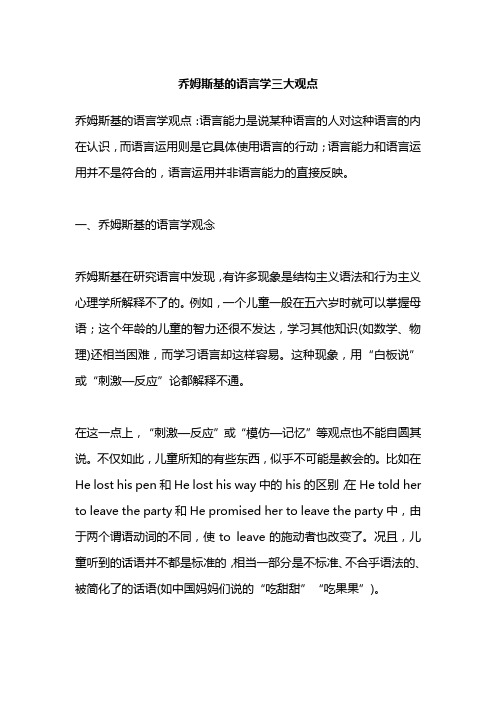
乔姆斯基的语言学三大观点乔姆斯基的语言学观点:语言能力是说某种语言的人对这种语言的内在认识,而语言运用则是它具体使用语言的行动;语言能力和语言运用并不是符合的,语言运用并非语言能力的直接反映。
一、乔姆斯基的语言学观念乔姆斯基在研究语言中发现,有许多现象是结构主义语法和行为主义心理学所解释不了的。
例如,一个儿童一般在五六岁时就可以掌握母语;这个年龄的儿童的智力还很不发达,学习其他知识(如数学、物理)还相当困难,而学习语言却这样容易。
这种现象,用“白板说”或“刺激—反应”论都解释不通。
在这一点上,“刺激—反应”或“模仿—记忆”等观点也不能自圆其说。
不仅如此,儿童所知的有些东西,似乎不可能是教会的。
比如在He lost his pen和He lost his way中的his的区别,在He told her to leave the party和He promised her to leave the party中,由于两个谓语动词的不同,使to leave的施动者也改变了。
况且,儿童听到的话语并不都是标准的,相当一部分是不标准、不合乎语法的、被简化了的话语(如中国妈妈们说的“吃甜甜”“吃果果”)。
但儿童最后学到的是标准的语言。
这显然不是靠简单模仿得来的。
儿童在五六年之内所接触的话语毕竟是有限的,然而,儿童能说出的句子却是无限的。
二、乔姆斯基的转换生成语法理论转换生成语法理论,亦称“转换语法理论”、“生成语法理论”。
是指一种新结构主义语言学理论。
美国语言学家乔姆斯基20世纪50-60年代创立。
用符号化和演绎方法描写自然语言生成语法的理论体系。
主要内容有:语言基本上不是习得的,而是天赋的。
儿童天生具有一种加工语言符号的大脑内在机制,随着儿童的发展,这种内在机制在一定的条件下被激发,儿童即能自然获得语言。
语言是一种结构,设想人有一种天生的“语言获得装置”,称LAD。
深层结构,指短语或句中的基本语法关系和语义,决定句子的内涵与意义,属语法的基础部分和语言能力。
简述乔姆斯基的语言观

简述乔姆斯基的语言观
乔姆斯基的语言观主要包括以下几个方面:
1. 乔姆斯基认为,语言能力是人类天生具有的内在属性,是基因和环境共同作用的结果。
人类具有一种先天的、与生俱来的习得语言的能力,这种能力是受遗传因素所决定的“语言习得机制”。
2. 乔姆斯基认为,语言是一种形式系统,具有生成性。
语言使用者可以生成和理解无限多的句子,这些句子符合语法规则。
语言使用者的语法知识是内化的,与具体的语境无关。
3. 乔姆斯基认为,语言学研究的对象是语言能力,而不是语言运用。
语言运用只是语言能力的表现形式,不能作为语言学研究的对象。
4. 乔姆斯基认为,语言的本质在于其句法结构。
语言的语法可以分为句法、语义和语用三个部分。
其中,句法是最核心的部分,因为语义和语用信息都是由句法结构决定的。
5. 乔姆斯基认为,语言的习得和发展是一个自然过程,不需要通过大量的语言输入和学习就能完成。
儿童在短短的几年内就能掌握一门语言的语法规则,这说明他们天生具有语言习得的能力。
总的来说,乔姆斯基的语言观强调了语言的内在属性、生成性和语法普遍性,认为人类天生具有语言习得的能力,而语言学的任务是揭示这种内在的语言能力。
乔姆斯基主要语言学观点

乔姆斯基主要语言学观点一、语言本质乔姆斯基认为,语言是一种本质上的人类能力,是自然选择机制的结果,用于解决交际中的问题。
他认为语言是人类神经系统的一个组成部分,而语言能力是与生俱来的。
他反对行为主义理论,认为语言行为不能通过刺激-反应的模仿学习来解释,因为语言的生成和理解过程需要复杂的认知和推理机制。
二、语言结构乔姆斯基认为,语言结构是由语法规则和词汇组成的。
语法规则包括词法、句法和语义三个部分,用于生成合乎语法的句子。
他提出了转换生成语法理论,认为语言知识本质上是一种规则系统,这些规则可以生成无限合乎语法的句子。
词汇是语法规则操作的对象,是语言的建筑材料。
三、语言生成乔姆斯基认为,语言的生成过程是由语法规则和词汇的组合来实现的。
语法规则可以生成无限合乎语法的句子,而词汇的加入则使这些句子具有实际意义。
他提出了短语结构规则和转换规则,认为这些规则可以生成所有合乎语法的句子。
他还提出了语言的递归性质,认为通过有限数量的规则可以在无限的语境中构建句子。
四、语言习得乔姆斯基认为,语言的习得是人类天生的一种能力,不需要通过模仿和强化来学习。
他认为儿童天生具有一种语言的初始状态,称为“普遍语法”。
在语言环境中接触到语言材料后,普遍语法与具体语言的语法相互作用,逐渐调整和修改普遍语法,最终形成特定语言的语法知识。
他还认为,儿童在语言习得过程中会犯错,但随着时间的推移,他们能够改正错误并最终习得正确的语法。
五、语言与思维乔姆斯基认为,语言和思维是相互依存的。
一方面,语言是思维的载体,帮助人们表达和交流思想;另一方面,语言也塑造了思维方式,对人们的认知和推理方式产生影响。
他强调语言的逻辑结构和语义关系在人类思维中的重要性。
他指出语言具有概念化、推理化和论证化的特性,对人类的认知和思维过程具有重要作用。
他还强调了语言的理性和逻辑性在人类思维中的重要地位。
乔姆斯基的语言观

乔姆斯基的语言观乔姆斯基(1928——)生于美国的费城。
美国著名哲学家,语言学家。
他的父亲是研究希伯来语的学者。
乔姆斯基曾在滨州大学学习,获得博士学位后,自1951年到1955年在哈佛大学进行研究工作;从1955年起在麻省理工学院现代语言系任教,同时在电子学研究实验室兼职。
他的研究领域主要是语言学,语言哲学和逻辑等。
乔姆斯基把语言研究和数学,现代数理逻辑结合起来,提出了新的语言理论,即转换生成语法,形成了一个语言学的新派别,即转换生成语法学派。
他的主要著作包括:《语法结构》(1957),《语言理论的当前问题》(1964),《语法理论面面观》(1965),《笛卡尔派语言学》(1966),《语言与精神》(1968),《美国权力与新官僚》(1969),《知识问题与自由》(1971),《生成语法的语义学研究》(1972),《语言理论的逻辑结构》(1975),《语言论》(1975),《规则与表达》(1980)。
乔姆斯基研究的不是一般语言现象,即语言的运用,而是语言能力。
他的转换生成语法就是关于语言能力的语法,这种语法理论的研究对象是“被理想化了的说话人和听话人的语言知识”。
他认为语言理论的主要任务是向人们提供选择语法时要依据的标准。
生成语法就是这样的语法理论,它的中心思想是:某一语言的语法应该生成所有的句子。
他认为语言能力是说某种语言的人对这种语言的内在认识,而语言运用则是它具体使用语言的行动。
在一般情况下,语言能力和语言运用并不是符合的,语言运用并非语言能力的直接反映。
乔姆斯基说,他的语言理论与索绪尔的语言理论有一定联系,索绪尔是区别语言与言语的关系,而他是区别语言能力与语言运用的关系。
但是他认为必须否定索绪尔的下述观点:语言是意义和声音的网络。
他认为语言能力是一种创造过程,他特别强调了语言的创造性。
乔姆斯基的语言哲学承认经验在人类掌握语言过程中所起的作用,但他认为经验不能单独起作用。
经验只具有激发天赋语言能力的功能。
乔姆斯基的语言学观点 英语
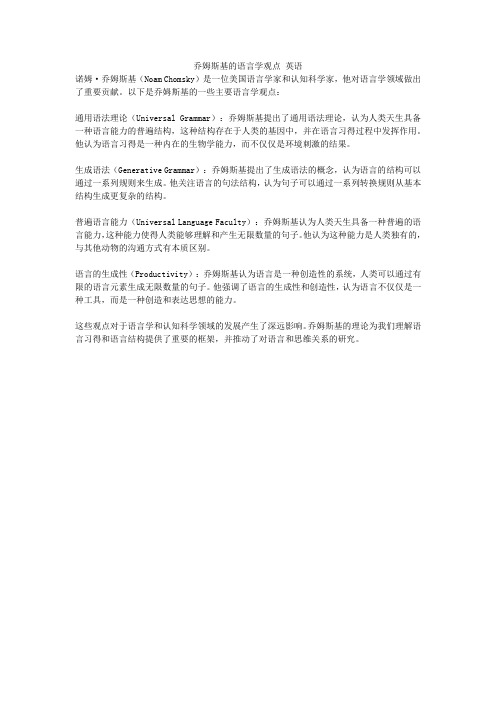
乔姆斯基的语言学观点英语
诺姆·乔姆斯基(Noam Chomsky)是一位美国语言学家和认知科学家,他对语言学领域做出了重要贡献。
以下是乔姆斯基的一些主要语言学观点:
通用语法理论(Universal Grammar):乔姆斯基提出了通用语法理论,认为人类天生具备一种语言能力的普遍结构,这种结构存在于人类的基因中,并在语言习得过程中发挥作用。
他认为语言习得是一种内在的生物学能力,而不仅仅是环境刺激的结果。
生成语法(Generative Grammar):乔姆斯基提出了生成语法的概念,认为语言的结构可以通过一系列规则来生成。
他关注语言的句法结构,认为句子可以通过一系列转换规则从基本结构生成更复杂的结构。
普遍语言能力(Universal Language Faculty):乔姆斯基认为人类天生具备一种普遍的语言能力,这种能力使得人类能够理解和产生无限数量的句子。
他认为这种能力是人类独有的,与其他动物的沟通方式有本质区别。
语言的生成性(Productivity):乔姆斯基认为语言是一种创造性的系统,人类可以通过有限的语言元素生成无限数量的句子。
他强调了语言的生成性和创造性,认为语言不仅仅是一种工具,而是一种创造和表达思想的能力。
这些观点对于语言学和认知科学领域的发展产生了深远影响。
乔姆斯基的理论为我们理解语言习得和语言结构提供了重要的框架,并推动了对语言和思维关系的研究。
简述乔姆斯基的语言观
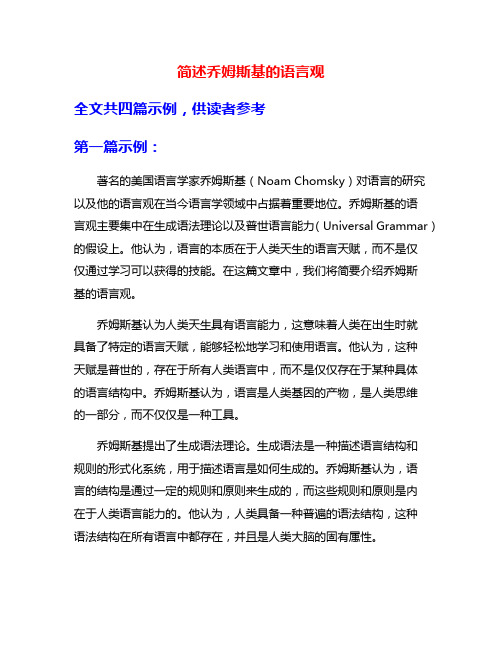
简述乔姆斯基的语言观全文共四篇示例,供读者参考第一篇示例:著名的美国语言学家乔姆斯基(Noam Chomsky)对语言的研究以及他的语言观在当今语言学领域中占据着重要地位。
乔姆斯基的语言观主要集中在生成语法理论以及普世语言能力(Universal Grammar)的假设上。
他认为,语言的本质在于人类天生的语言天赋,而不是仅仅通过学习可以获得的技能。
在这篇文章中,我们将简要介绍乔姆斯基的语言观。
乔姆斯基认为人类天生具有语言能力,这意味着人类在出生时就具备了特定的语言天赋,能够轻松地学习和使用语言。
他认为,这种天赋是普世的,存在于所有人类语言中,而不是仅仅存在于某种具体的语言结构中。
乔姆斯基认为,语言是人类基因的产物,是人类思维的一部分,而不仅仅是一种工具。
乔姆斯基提出了生成语法理论。
生成语法是一种描述语言结构和规则的形式化系统,用于描述语言是如何生成的。
乔姆斯基认为,语言的结构是通过一定的规则和原则来生成的,而这些规则和原则是内在于人类语言能力的。
他认为,人类具备一种普遍的语法结构,这种语法结构在所有语言中都存在,并且是人类大脑的固有属性。
乔姆斯基的语言观对当今语言学研究产生了深远影响。
他的理论为我们提供了一种全新的视角来理解语言的本质和结构。
他的研究挑战了传统的行为主义观点,认为语言是一种天赋,而不是简单的习得。
乔姆斯基的观点激发了许多语言学家和心理学家对语言学习过程的深入思考,为我们更好地理解语言学习的机制和原则提供了重要参考。
第二篇示例:译者按:瓦茨拉夫·约瑟夫·乔姆斯基(Vaclav Jzef Czemski,1929-1997)是20世纪著名的语言学家、哲学家和认知心理学家,他对语言和思维之间的关系进行了深入观察和研究,提出了许多有关语言结构和意义的重要理论。
本文将简要介绍乔姆斯基的语言观。
乔姆斯基是现代结构主义语言学的创始人之一,他认为语言是人类思维活动的产物,是人类独特的认知工具。
乔姆斯基的语言学三大观点

乔姆斯基的语言学三大观点
乔姆斯基是20世纪最具影响力的语言学家之一,他提出了许
多重要的语言学理论和观点。
其中最为著名的就是他的语言学三大观点,分别是生成语法、普遍语法和语言习得理论。
生成语法是乔姆斯基提出的一种语言描述方法,它认为人类语言的规则是由一系列生成规则组成的。
这些生成规则可以用来产生一个句子的所有可能性,从而描述这个句子的语法结构。
生成语法的最大特点是它强调了语言规则的内在结构和系统性,这使得我们能够更加深入地理解语言的本质。
普遍语法是乔姆斯基提出的另一个重要观点,它认为人类语言之间存在着一些普遍的语法规律。
这些规律并不是由个体语言习得而来的,而是人类大脑先天具备的一种普遍能力。
普遍语法的提出使得我们能够更好地理解不同语言之间的联系和差异,同时也为我们研究人类语言习得提供了新的视角。
最后一个重要观点是乔姆斯基的语言习得理论。
他认为人类语言习得并不是通过模仿和记忆来完成的,而是通过一种内在的、先天的语言能力来实现的。
这种能力使得婴儿能够在没有任何外部指导的情况下,自然而然地掌握自己母语的语音、词汇和语法规则。
这个理论对于我们理解人类语言习得过程有着重要的意义,同时也为我们研究人工智能和机器翻译提供了新的思路。
总之,乔姆斯基的三大语言学观点为我们深入理解人类语言本质提供了重要的理论支持。
这些观点不仅对于语言学界有着重要意义,同时也对于其他领域如人工智能、机器翻译等有着广泛的应用价值。
乔姆斯基的语言学的基本观点和外语教学

乔姆斯基的语言学的基本观点和外语教学1.乔姆斯基的语言学理论乔姆斯基是美国语言学家,转换生成语法的创始人。
他富有探索精神,先是用结构主义的方法研究希伯来语。
他的研究有三个阶段:(1)第一阶段是古典理论时期,认为语义和语法分析无关。
(2)标准理论阶段,认为语法分析可以纳入理论,但转换规则只改变句子结构,不改变意义。
(3)扩充式标准理论阶段,认为表层结构对于语义解释也起一定作用,转换不仅改变句子结构,有时也改变意义。
他采用演绎法进行研究,先提出假设,再搜集资料,最后验证假设。
通过深入研究個别的语言,他总结出人们无需学习便可以掌握的语言规律。
笛卡尔具有“天赋观念说”,认为人的很多公理和原则不是来自经验,而是“先验的”。
“知识的内容是后天的,但使知识成为可能的东西不是后天的,而是先验的,不是来自经验的,而是与经验无关的”。
他还把这种天赋观念说扩展到天赋的认识能力。
而乔姆斯基在研究中也发现一些现象是结构主义和行为主义心理学解释不了的。
例如儿童五六岁就可以学会语言,这时他们还没有学习能力,学习语言却如此容易。
而且儿童各有天赋,却在语言学习上1的差别很罕见。
乔姆斯基认为:“很难令人相信,一个生来对语言的基本性质毫无所知的机体可以学会语言的结构。
”他称儿童的这种能力为语言习得机制。
他的转换生成语法认为语法分为“基础部分”和“转换部分”,基础部分形成深层语法,语音部分是表层部分,它给深层部分做出解释。
“表层结构”是句子表现出来的意义,而“深层结构”表示意义,不能被感知。
“深层结构”有三种特性:1.表达意义,2.生成表层结构,3.由基础部分决定其形式。
生成语法假设人类大脑中的语法知识由两部分构成:一部分是各种语言特有的规则,通过后天学习、训练获得;另一部分是所有语言共有的原则,通过生物遗传在大脑物质结构中固定下来。
规则生成合格的句子,原则限制规则,防止生成不合格的句子。
二者互为配合、制约形成丰富的语法。
人脑中具有学习语言的天赋,乔姆斯基凭借一道公式来描写语言能力的形式。
乔姆斯基的语言观

乔姆斯基的推理
• 乔姆斯基用推理的方法对“语言习得机制” language acquisition device进行设想
– 关于人类大脑初始结构的猜测:人脑的初始结 构对人类一切语言有大致的了解→人脑的初始 状态应该包括人类一切语言共同具有的特点, 可成为“普遍语法”universal grammar或“语 言普遍现象”linguistic universals,分为:
揭示语言能力之后,还要与普遍语法联系起来(才能与人脑的初始状 态联系起来,才可能揭示人的认知系统)
乔姆斯基的语言理论有支持者,也有 反对者,但其影响是不可忽视的。他 的理论为语言学打开了一个新局面, 使许多语言学家重新考虑语言的性质 和语言学的任务。
——THE END
理想条件下的语 言知识 潜含的 稳定的、长久的 在不同时间、地 点、场合,表现 为不同的语言行 为
语言运用 适当场合具体使 用
外露的 多变的、瞬息的 不会完全反应语言 能力,受说话人记 忆、情绪等条件的 限制
评价语法的三个平面
• 乔姆斯基认为,研究语言能力就是为了建 立一种反映语言能力的生成语法,它不以 具体语言的描写为归宿,而是以具体语言 为出发点,探索语言的普遍规律,最终弄 清人不同平面来评价语法
评价语法的三个平面
观察充分性平面(observational adequacy):
能对原始语言材料做出正确解释的语法
描写充分性平面(descriptive adequacy):
不仅要正确解释原始语言材料,还要正确解释说话人和听话人的内在 语言能力,也就是他们的语言知识,如:英语中的重音规则
解释充分性平面(explanatory adequacy):
• 普遍语法过渡到个别语法需要“经验”的“触发” “经验” ↓ 普通语法(UG) 个别语法(PG)
论乔姆斯基语言观的习得
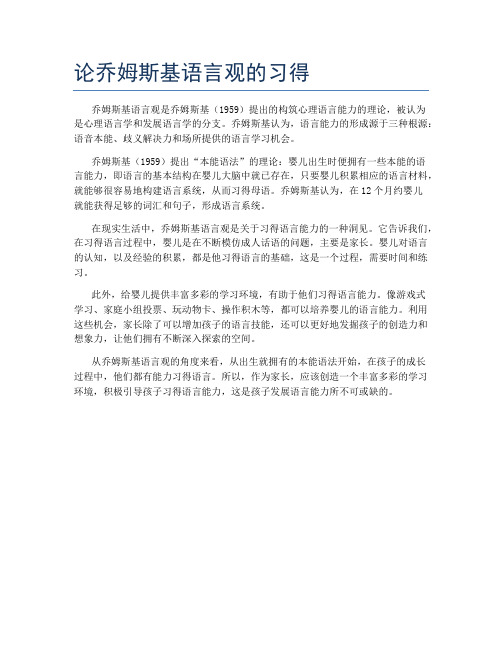
论乔姆斯基语言观的习得
乔姆斯基语言观是乔姆斯基(1959)提出的构筑心理语言能力的理论,被认为
是心理语言学和发展语言学的分支。
乔姆斯基认为,语言能力的形成源于三种根源:语音本能、歧义解决力和场所提供的语言学习机会。
乔姆斯基(1959)提出“本能语法”的理论:婴儿出生时便拥有一些本能的语
言能力,即语言的基本结构在婴儿大脑中就已存在,只要婴儿积累相应的语言材料,就能够很容易地构建语言系统,从而习得母语。
乔姆斯基认为,在12个月约婴儿
就能获得足够的词汇和句子,形成语言系统。
在现实生活中,乔姆斯基语言观是关于习得语言能力的一种洞见。
它告诉我们,在习得语言过程中,婴儿是在不断模仿成人话语的问题,主要是家长。
婴儿对语言的认知,以及经验的积累,都是他习得语言的基础,这是一个过程,需要时间和练习。
此外,给婴儿提供丰富多彩的学习环境,有助于他们习得语言能力。
像游戏式
学习、家庭小组投票、玩动物卡、操作积木等,都可以培养婴儿的语言能力。
利用这些机会,家长除了可以增加孩子的语言技能,还可以更好地发掘孩子的创造力和想象力,让他们拥有不断深入探索的空间。
从乔姆斯基语言观的角度来看,从出生就拥有的本能语法开始,在孩子的成长
过程中,他们都有能力习得语言。
所以,作为家长,应该创造一个丰富多彩的学习环境,积极引导孩子习得语言能力,这是孩子发展语言能力所不可或缺的。
乔姆斯基的语言观
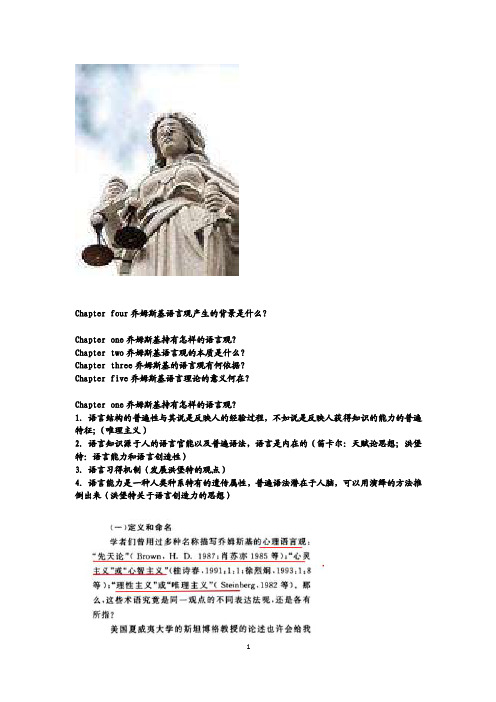
Chapter four乔姆斯基语言观产生的背景是什么?Chapter one乔姆斯基持有怎样的语言观?Chapter two乔姆斯基语言观的本质是什么?Chapter three乔姆斯基的语言观有何依据?Chapter five乔姆斯基语言理论的意义何在?Chapter one乔姆斯基持有怎样的语言观?1. 语言结构的普遍性与其说是反映人的经验过程,不如说是反映人获得知识的能力的普遍特征;(唯理主义)2. 语言知识源于人的语言官能以及普遍语法,语言是内在的(笛卡尔:天赋论思想;洪堡特:语言能力和语言创造性)3. 语言习得机制(发展洪堡特的观点)4. 语言能力是一种人类种系特有的遗传属性,普遍语法潜在于人脑,可以用演绎的方法推倒出来(洪堡特关于语言创造力的思想)A. 乔姆斯基语言理论的基本假设和目标一、乔姆斯基语言学理论的基本假设二、乔姆斯基语言理论的研究对象三、乔姆斯基语言理论的研究目标B. 语言学的学科性质和研究方法一、语言学的学科性质二、乔姆斯基语言学的研究方法三、语言研究的表达形式C. 乔姆斯基理论的发展历程正文:A. 乔姆斯基语言理论的基本假设和目标一、乔姆斯基语言学理论的基本假设1. 天赋论假设Innateness Hypothesis:人的语法知识是天赋的假设起源:古希腊哲人柏拉图提出这样的疑问:尽管人类在其短暂的一生中与世界的接触如此少,但为何他们的知识却是如此丰富?乔氏观点:语言天赋假设人类天生具有语言能力,这个能力满足了感官系统对语言数据进行初步的分析处理,同时又提供了一套系统组合,确定某一特定语法。
他曾经引用了James Harris的比喻:‚知识的增长… (有点类似于)…果实的生长,不论各种外因相互作用到何种程度,树的内在活力和品质才是最终使果实成熟的因素‛对行为主义的批判:(行为主义心理学认为:语言习得是外部刺激的结果。
B.F. Skinner用‚习惯‛来解释人的语言习得。
乔姆斯基的语言学观点意义

乔姆斯基的语言学观点具有非常重要的意义,主要体现在以下几个方面:
1.
揭示了语言的本质:乔姆斯基的语言学观点认为语言是一种天赋,是人类天生就具备的能力。
这一观点揭示了语言的本质,即语言是人类思维和认知的基础,是人类社会交流的重要工具。
2.
推动了语言学的发展:乔姆斯基的语言学观点为语言学的发展提供了新的思路和方法。
他的转换生成语法理论为语言学研究提供了新的视角和工具,推动了语言学的发展和创新。
3.
促进了认知科学的发展:乔姆斯基的语言学观点与认知科学密切相关。
他认为语言是认知的一部分,是人类思维和认知的基础。
因此,他的语言学观点为认知科学的发展提供了重要的理论支持和实践指导。
4.
启示了教育领域:乔姆斯基的语言学观点对于教育领域也有着重要的启示。
他认为语言教学应该注重培养学生的语言能力和思维能力,而不是仅仅注重语言知识的传授。
这一观点对于教育领域的教学方法和课程设计有着重要的指导意义。
总之,乔姆斯基的语言学观点对于语言学、认知科学和教育领域都有着重要的意义和影响。
乔姆斯基的语言观

乔姆斯基的语言观乔姆斯基的语言学认为:语言能力是说某种语言的人对这种语言的内在认识,而语言运用则是它具体使用语言的行动;语言能力和语言运用并不是符合的,语言运用并非语言能力的直接反映。
简单说就是,人类具有一种先天的、与生俱来的习得语言的能力,这种能力是受遗传因素所决定的“语言习得机制”。
乔姆斯基语言学观点介绍乔姆斯基把语言分为语言能力与语言行为二方面。
语言能力追溯至生理上人类智力里已有的“普遍语法”,普遍语法加上不同的参数形成各种具体的人类语言,这些参数是由历史选择与积累的,并体现为社会拥有的母语的特征、使用规则、甚至直觉。
语言行为是语言的具体使用与结果。
传统语言学是从语言行为研究语言的,在乔姆斯基看来这是经验主义的做法。
乔姆斯基的语言学是以语言能力为研究对象,期望通过对语言能力的研究可以解释人类语言的习得机制。
相对于经验主义,乔姆斯基语言研究具有理性主义色彩,乔姆斯基构建形式的符号系统,通过符号系统规则的递归应用,可以从基本的词库生成所有人类语言语句,包括已有的语句以及潜在无穷的语句。
然后通过对这个符号系统的逐步求精可以认知到人类的语言能力。
乔姆斯基认为说话的方式(词序)遵循一定的句法,这种句法是以形式的语法为特征的,具体而言就是一种不受语境影响并带有转换生成规则的语法。
儿童被假定为天生具有适用于所有人类语言的基本语法结构的知识。
这种与生俱来的知识通常被称作普遍语法理论。
其研究对象是内在性语言,而不是一般语言学家所研究的外表化语言。
其研究范围限于人的语言知识或语言能力,而不是语言的使用,即它一般不研究话语的社会内容、交际功能和说话的环境等。
乔姆斯基的观点曾被人指责为“天生主义”。
乔姆斯基反驳说,其实“天生主义”到处都有,生物学中有不少“天生主义”。
人长有胳膊,眼睛能看见物体,妇女能孩子,这些不是天生的又是什么?如果有人宣布,由于某种偶然的“经验”或“刺激”而突然长出一只胳膊,那一定会被认为是荒谬绝伦的。
乔姆斯基的观点
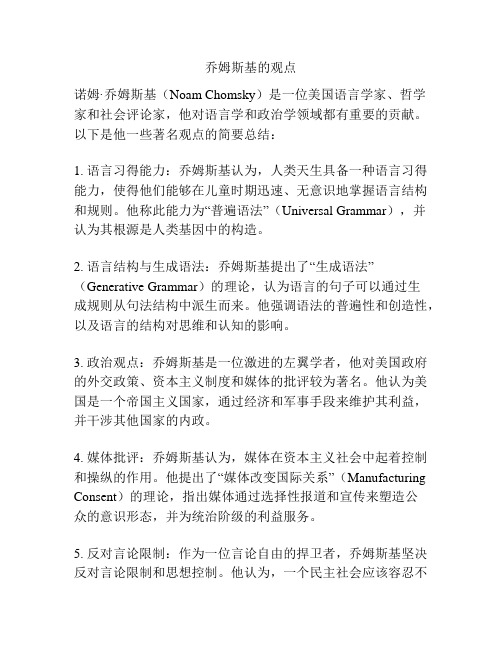
乔姆斯基的观点
诺姆·乔姆斯基(Noam Chomsky)是一位美国语言学家、哲学
家和社会评论家,他对语言学和政治学领域都有重要的贡献。
以下是他一些著名观点的简要总结:
1. 语言习得能力:乔姆斯基认为,人类天生具备一种语言习得能力,使得他们能够在儿童时期迅速、无意识地掌握语言结构和规则。
他称此能力为“普遍语法”(Universal Grammar),并
认为其根源是人类基因中的构造。
2. 语言结构与生成语法:乔姆斯基提出了“生成语法”(Generative Grammar)的理论,认为语言的句子可以通过生
成规则从句法结构中派生而来。
他强调语法的普遍性和创造性,以及语言的结构对思维和认知的影响。
3. 政治观点:乔姆斯基是一位激进的左翼学者,他对美国政府的外交政策、资本主义制度和媒体的批评较为著名。
他认为美国是一个帝国主义国家,通过经济和军事手段来维护其利益,并干涉其他国家的内政。
4. 媒体批评:乔姆斯基认为,媒体在资本主义社会中起着控制和操纵的作用。
他提出了“媒体改变国际关系”(Manufacturing Consent)的理论,指出媒体通过选择性报道和宣传来塑造公
众的意识形态,并为统治阶级的利益服务。
5. 反对言论限制:作为一位言论自由的捍卫者,乔姆斯基坚决反对言论限制和思想控制。
他认为,一个民主社会应该容忍不
同意见和多样性,而不是压制异议声音。
以上是乔姆斯基的一些重要观点,他的学术成就和社会评论广泛影响了许多领域的研究和思考。
乔姆斯基的语言观
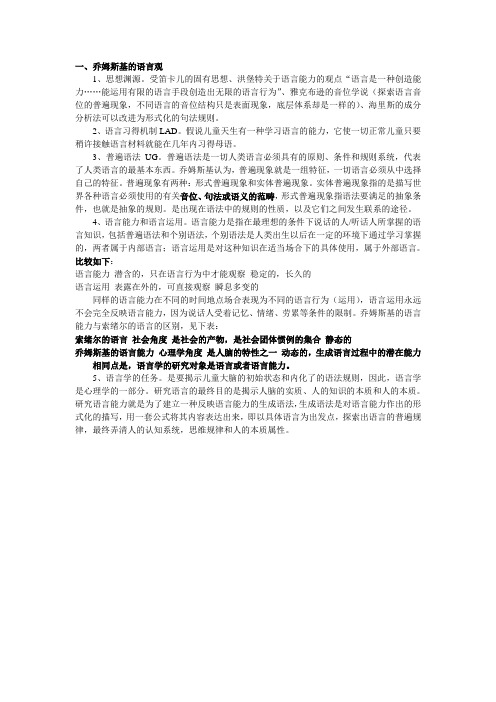
一、乔姆斯基的语言观1、思想渊源。
受笛卡儿的固有思想、洪堡特关于语言能力的观点“语言是一种创造能力……能运用有限的语言手段创造出无限的语言行为”、雅克布逊的音位学说(探索语言音位的普遍现象,不同语言的音位结构只是表面现象,底层体系却是一样的)、海里斯的成分分析法可以改进为形式化的句法规则。
2、语言习得机制LAD。
假说儿童天生有一种学习语言的能力,它使一切正常儿童只要稍许接触语言材料就能在几年内习得母语。
3、普遍语法UG。
普遍语法是一切人类语言必须具有的原则、条件和规则系统,代表了人类语言的最基本东西。
乔姆斯基认为,普遍现象就是一组特征,一切语言必须从中选择自己的特征。
普遍现象有两种:形式普遍现象和实体普遍现象。
实体普遍现象指的是描写世界各种语言必须使用的有关音位、句法或语义的范畴,形式普遍现象指语法要满足的抽象条件,也就是抽象的规则。
是出现在语法中的规则的性质,以及它们之间发生联系的途径。
4、语言能力和语言运用。
语言能力是指在最理想的条件下说话的人/听话人所掌握的语言知识,包括普遍语法和个别语法,个别语法是人类出生以后在一定的环境下通过学习掌握的,两者属于内部语言;语言运用是对这种知识在适当场合下的具体使用,属于外部语言。
比较如下:语言能力潜含的,只在语言行为中才能观察稳定的,长久的语言运用表露在外的,可直接观察瞬息多变的同样的语言能力在不同的时间地点场合表现为不同的语言行为(运用),语言运用永远不会完全反映语言能力,因为说话人受着记忆、情绪、劳累等条件的限制。
乔姆斯基的语言能力与索绪尔的语言的区别,见下表:索绪尔的语言社会角度是社会的产物,是社会团体惯例的集合静态的乔姆斯基的语言能力心理学角度是人脑的特性之一动态的,生成语言过程中的潜在能力相同点是,语言学的研究对象是语言或者语言能力。
5、语言学的任务。
是要揭示儿童大脑的初始状态和内化了的语法规则,因此,语言学是心理学的一部分。
研究语言的最终目的是揭示人脑的实质、人的知识的本质和人的本质。
乔姆斯基的观点

乔姆斯基是语言学家和哲学家,他的观点主要集中在语言学和认知科学领域。
以下是他的几个主要观点:1.语言和思维的关系:乔姆斯基认为语言不仅仅是交流的工具,而且是思维和认知的重要组成部分。
他提出了“普遍语法”(Universal Grammar)的概念,认为人类天生具备一种语言学习的能力和结构。
这一观点挑战了传统的行为主义语言学观点,并成为了现代认知科学的重要基础之一。
2.语言的社会功能:乔姆斯基认为语言不仅仅是个体交流的工具,而且是社会交往和权力斗争的重
要工具。
他提出了“生成语法”(Generative Grammar)的概念,强调语言是一种社会行为,并受到特定社会和文化环境的影响。
3.对越南战争的批判:乔姆斯基是越南战争的主要反对者之一。
他尖锐地批评了战争的残虐和旁观
者的冷漠,引发了知识分子对责任的深思。
他曾当选为领导全球政府的11人之一,对世界各地的政局发表评论,并撰写了大量著作。
4.对美国外交政策的批判:乔姆斯基对美国外交政策及美国权力合法性的批判影响深远,并因而成
为富有争议的人物。
他对美国政治痛彻心扉的分析,毫不隐藏地抛出每一个世界事件背后的人类要面临的威胁,得到了更多民众的支持和喜爱。
- 1、下载文档前请自行甄别文档内容的完整性,平台不提供额外的编辑、内容补充、找答案等附加服务。
- 2、"仅部分预览"的文档,不可在线预览部分如存在完整性等问题,可反馈申请退款(可完整预览的文档不适用该条件!)。
- 3、如文档侵犯您的权益,请联系客服反馈,我们会尽快为您处理(人工客服工作时间:9:00-18:30)。
On C homsky’s View of LanguageAbstract: As a pioneer linguist,Noam Chomsky enjoys a position within linguistics probably unprecedented in the whole history of the subject. From his first book Syntactic Structures, published in 1957, he has been engaged in the linguistic study and brought many innovative ideas to linguistics, especially in the aspects of grammatical theory. His theory of grammar is undoubtedly the most dynamic and influential.This thesis reviews the development of Chomsky’s linguistic the ories and its philosophical foundation for linguistics, including his major contributions, like the theory of transformational-generative grammar that revolutionalized the scientific study of language. This systematic and historical overview of his linguistic studies will surely help to get a deeper understanding of Chomsky’s academic contributions and give a mathematically precise description of some of the most striking features of language.Key words: view of language; philosophical foundation for linguistics1.IntroductionNoam Chomsky is one of the most influential thinkers of modern times. The most cited writer in the humanities, his work has revolutionized the field of linguistics, and has dominated many other disciplines including politics and the philosophy of mind and human nature. He has also contributed significantly to our understanding of the abuse of power, and of the controlling effects of the mass media.Since the very day on which Chomsky’s theories were established, there have been many arguments. There are many faithful followers,while some people are radical objectors. Many researches have been made on his linguistic ideas and there have been quite a few breakthroughs. However, most of the study is limited to a certain developmental period of his theories, or an introduction of a certain theoretical work.This thesis aims to make an exploration of Chomsky’s linguistic ideas, which makes up for the limitation of previous researches. This is not only an exploration of a great linguist’s the ory, but also an exploration of the linguistic development since 1957. By doing this research, we can absorb some conducive experience and study methods.In the following chapter, I will make a comprehensive study of Chomsky’s linguistic revolution, namely the transformational grammar. In Chapter Three, we can see the major developmental phases of Chomsky’s linguistic ideas, from the transformational grammar, to Standard Theory, Extended Standard Theory, REST, GB to Minimalist Program. Chapter Four focuses on the philosophical foundation of his linguistic concept, which constitutes the bedrock on which the rest is built. In the last chapter, I will summarize the creative findings and the significance of them, including the great impact on the past and present linguistic study and the outlook of future development.2.Chomsky and His Linguistic Ideas2.1 BiographyNoam Chomsky was born on December 7, 1928 in Philadelphia, Pennsylvania. His undergraduate and graduate years were spent at the University of Pennsylvania where he received his PhD in linguistics in 1955. During the years 1951 to 1955, Chomsky was a Junior Fellow of the Harvard University Society of Fellows. While a Junior Fellow hecompleted his doctoral dissertation entitled, "Transformational Analysis." The major theoretical viewpoints of the dissertation appeared in the monograph Syntactic Structure, which was published in 1957. This formed part of a more extensive work, The Logical Structure of Linguistic Theory, circulated in mimeograph in 1955 and published in 1975.Chomsky received a faculty position at the Massachusetts Institute of Technology in 1955 and in 1961 was appointed full professor in the Department of Modern Languages and Linguistics (now the Department of Linguistics and Philosophy.) From 1966 to 1976 he held the Ferrari P. Ward Professorship of Modern Languages and Linguistics. In 1976 he was appointed Institute Professor.Chomsky has received honorary degrees from University of London, University of Chicago, Loyola University of Chicago, Swarthmore College, Delhi University, Bard College, University of Massachusetts, University of Pennsylvania, Georgetown University, Amherst College, Cambridge University, University of Buenos Aires, McGill University, Universitat Rovira I Virgili, Tarragona, Columbia University, University of Connecticut, Scuola Normale Superiore, Pisa, University of Western Ontario, University of Toronto, Harvard University, University of Calcutta, and Universidad Nacional De Colombia. He is a Fellow of the American Academy of Arts and Sciences and the National Academy of Science. In addition, he is a member of other professional and learned societies in the United States and abroad, and is a recipient of the Distinguished Scientific Contribution Award of the American Psychological Association, the Kyoto Prize in Basic Sciences, the Helmholtz Medal, the Dorothy Eldridge Peacemaker Award, the Ben Franklin Medal in Computer and Cognitive Science, and others.Alongside his career as a linguist, Chomsky has been active in left-wing politics. In 1965 he organized a citizen's committee to publicize tax refusal in protest to the war in Vietnam; four years later he published his first book on politics American Power and the New Mandarins. By the 1980's he had become both the most distinguished figure of American linguistics and one of the most influential left-wing critics of American foreign policy. He has been extremely prolific as a writer: his web-site in 2003 listed 33 book publications in linguistics (broadly construed), and although the individuation of his political books is complicated, their number definitely exceeds 40. According to a 1992 tabulation of sources from the previous 12 years in the Arts and Humanities Citation Index, Chomsky was the most frequently-cited person alive, and one of the eight most frequently-cited authors of all time.2.2 Linguistic Revolution2.2.1 Finite-State GrammarsThe aim of the linguistic theory by Chomsky in Syntactic Structures (1957) was essentially to describe syntax, to specify the grammatical rules underlying the construction of sentences. In Syntactic Structure, Chomsky discussed “three models for the description of language”. Before going to deal with these three models, we have to make clear about some assumptions. The first is the language that is described by a particular grammar as the set of all the sentences it generates. In principle, the set of sentences may be finite or infinite in number. However, English comprises an infinite number of sentences, because there are sentences and phrases in the language that can be extended indefinitely and will yet be accepted as perfectly normal by native speakers. The point is that no definite limit can be set to the length of English sentences. Therefore, intheory, the number of grammatical sentences in the language is infinite while the number of words in the vocabulary of English is finite. There is also assumption that the distinct operations that are involved in the generation of English sentences are finite in number. If the grammar is to consist of a finite set of rules operating upon a finite vocabulary and is to be capable of generating an infinite set of sentences, it follows that at least some of the rules must be applicable more than once in the generation of the same sentences. These rules and the structures that they generate are recursive in nature.The simplest grammars that Chomsky discusses are capable of generating an infinite set of sentences by means of a finite number of recursive rules operating upon a finite vocabulary. These are what he calls finite-state grammars. Chomsky gradually found out the inadequacy of finite-grammars because there are certain regular processes of sentence formation in English that cannot be accounted for within the framework of finite-state grammar.Chomsky gradually found out the inadequacy of finite-grammars because there are certain regular processes of sentence formation in English that cannot be accounted for within the framework of finite-state grammar.2.2.2 Phrase Structure GrammarIn order to make up for the deficiency of finite-state grammars, Chomsky made the second of his “three models for the description of language”, phrase structure grammar. There are sets of sentences that can be generated by a phrase structure grammar but not by a finite-state grammar. As we all know, the first task of Chomsky's syntax is to account for the speaker's understanding of the internal structure ofsentences. In the view of Chomsky, sentences are not unordered strings of words, rather the words and morphemes are grouped into functional constituents such as the subject of the sentence, the predicate, the direct object, and so on. Two strings of elements may have the same linear structure but differ with respect to their phrase structure, and the difference in their phrase structure may be semantically relevant. This phenomenon is “constructional homonymity” in Syntactic Structures or structural ambiguity. With this mode of syntactic structure, Chomsky is the first to show how it could be formalized by means of a system of generative rules and to Chomsky claims that the phrase structure rules constructed by the grammarian "represent" the speaker’s competence. Though phrase structure were already implicit, such rules were not adequate to account for all the syntactical facts of natural languages.Phrase structure rules alone could not account for the various sorts of cases such as "I like her cooking" and "John is eager to please." John R. Searle made some analyses in Chomsky’s Revolution in Linguistic s. First, within such a grammar there is no natural way to describe the ambiguities in a sentence such as "I like her cooking." Phrase structure rules alone would provide only one derivation for this sentence; but as the sentence is syntactically ambiguous, the grammar should reflect that fact by providing several different syntactical derivations and hence several different syntactical descriptions. Secondly, phrase structure grammars have no way to picture the differences between "John is easy to please" and "John is eager to please." Though the sentences are syntactically different, phrase structure rules alone would give them similar phrase markers. Thirdly, just as in the above examples surface similarities conceal underlying differences that cannot be revealed by phrase structure grammar, so surface differences also conceal underlyingsimilarities. For example, in spite of the different word order and the addition of certain elements, the sentence "The book will be read by the boy" and the sentence "The boy will read the book" have much in common: they both mean the same thing—the only difference is that one is in the passive mood and the other in the active mood. Phrase structure grammars alone give us no way to picture this similarity.They would give us two unrelated descriptions of these two sentences. Chomsky has not been able to prove the possibility that there are sentences that cannot be generated by phrase structure. But in Syntactic Structures, he claims there are sentences that can only be desc ribed “clumsily” within the framework of phrase structure grammar, in an unrevealing or ad hoc way.2.2.3 Transformational GrammarAs the last one of “three models for the description of language”, transformational grammar, which is far more complex than phrase structure grammar, yields a “simpler” description of certain sentences.A transformational grammar doesn’t consist only of transformational rules, but a set of phrase structure rules as well. Different phrase markers produced by the phrase structure rules are transformed into the same phrase marker by the application of the transformational rules. One of the advantages the earlier version of transformational grammar presented in Syntactic Structures was that it could account more satisfactorily than phrase structure grammar for certain type of structural ambiguity. For example, “Flying planes can be dangerous” is ambiguous. (To fly planes can be dangerous and Planes that are flying can be dangerous). The structurally ambiguous sentences can be accounted for rather nicely in terms of transformational grammar. Instead of generating two unrelatedphrase markers by phrase structure rules, we can construct a simpler grammar by showing how both the active and the passive can be derived from the same underlying phrase marker. Instead of rewriting one element as a string of elements, a transformational rule maps one phrase marker into another. Transformational rules therefore apply after the phrase structure rules have been applied; they operate on the output of the phrase structure rules of the grammar.One of the advantages the earlier version of transformational grammar presented in Syntactic Structures was that it could account more satisfactorily than phrase structure grammar for certain type of structural ambiguity. For example, “Flying planes can be dangerous” is ambiguous. ( To fly planes can be dangerous and Planes that are flying can be dangerous). The structurally ambiguous sentences can be accounted for rather nicely in terms of transformational grammar. With the introduction of transformational rules, Chomsky's grammars are often called“transformational grammars”.3. Major Developmental Phases of Chomsky's Linguistic TheorySince the turning out of his first book Syntactic Structure in which he formulated his transformational grammar, Chomsky has updated his extensively-applied linguistic notions with more lectures given and books issued. It is commonly recognized to be five phases.Phase One: Transformational GrammarIt is impossible to understand C homsky’s linguistic notions without understanding his transformational grammar which is undoubtedly a milestone in the history of modern linguistics. Prior to the publication of Syntactic Structure in 1957, the linguistic study was mainly concernedwith structuralism. Structural linguistics, with its insistence on objective methods of verification and precisely specified techniques of discovery, derives from the "behavioral sciences" approach to the study of man, and is also largely a consequence of the philosophical assumptions of logical positivism.During that period, most American linguists, according to Chomsky,defined the task of linguistics as “collecting language elements and classifying them”(Chomsky 1970:100). The approach was the mechanic procedure to find the language truth and discipline. Linguistics was a kind of verbal botany. Linguists at that time were just giving a description of a language by colleting data, colleting a large number of utterances of language. These utterances were always recorded on a tape recorder or in a phonetic script. The second step was to classify these elements of language at different linguistic levels, from the units of sounds, the phonemes, to the morphemes, then to the sequences of word classes. The study target was the rich language elements and structuralism was inductive with a word-grammar.However, with the language ability as the study target, TG aims to establish some theories, by means of which we can make sure which rules form the basis of language structure. The aim of linguistic theory was to provide the linguist with a set of rigorous methods, a set of discovery procedures which he would use to extract from the "corpus" the phonemes, the morphemes, and so on. Its approach is putting forward hypothesis which is to be tested by native language speakers. Therefore, TG is a deductive language-category grammar which can explain infinite sentences with limited analyses.John R. Searle concludes that:Chomsky argued that since any language contains an infinite number of sentences, any "corpus," even if it contained as many sentences as there are in all the books of the Library of Congress, would still be trivially small. Instead of the appropriate subject matter of linguistics being a randomly or arbitrarily selected set of sentences, the proper object of study was the speaker's underlying knowledge of the language, his "linguistic competence" that enables him to produce and understand sentences he has never heard before.(Searle 1972: 29) Once the conception of the "corpus" as the subject matter is rejected, then the notion of mechanical procedures for discovering linguistic truths goes as well. Chomsky argues that no science has a mechanical procedure for discovering the truth anyway. Rather, what happens is that the scientist formulates hypotheses and tests them against evidence. Linguistics is no different: the linguist makes conjectures about linguistic facts and tests them against the evidence provided by native speakers of the language. He has in short a procedure for evaluating rival hypotheses, but no procedure for discovering true theories by mechanically processing evidence.The Transformational Grammar can be expressed in the following way: a. Two levels of representation of the structure of sentences: an underlying, more abstract form, termed 'deep structure', and the actual form of the sentence produced, called 'surface structure'. Deep structure is represented in the form of a hierarchical tree diagram, or "phrase structure tree," depicting the abstract grammatical relationships between the words and phrases within a sentence.b. A system of formal rules specifying how deep structures are to be transformed into surface structures.Like a revolution, the transformational grammar established the basis for other subsequent theories of human grammatical knowledge. Since Chomsky's original presentation, many different theories have emerged. With the notion of a transformation remaining a central element in most models, concepts like deep structure and surface structure, phrase structure tree, phrase structure rules, verb phrase, noun phrase, creativity/ productivity became the grammatical elements in language study.Phase Two: Language Competence and Performance; Standard TheoryIn Aspects of the Theory of Syntax in 1965, Chomsky put forward two sets of concepts, which are now widely known. One is competence and performance and the other deep structure and surface structure. Chomsky defines competence as the ideal user's knowledge of the rules of his or her language, and performance the actual realization of this knowledge in linguistic communication.According to Chomsky,speakers have internalized a set of rules about their language. This rule system enables them to produce and understand an infinitely large number of sentences and recognize sentences that are ungrammatical and ambiguous. Chomsky holds that linguists should study the ideal speaker's competence, because the speaker's performance is too haphazard to be studied. Thus, the task of the linguists is to discover the speaker's internalized rules. Competence is independent from performance. The difference between them is like that between knowledge of language and use of that language. Although the investigation of competence is challenging because of the complexity of our knowledge of language, performance is observable. From this point,Chomsky began to look at language from a psychological point of view and consider linguistic competence as a property of the mind of a speaker.In order to explain the difference between "performance" (all sentences that an individual will ever use) and "competence" (all sentences that an individual can utter, but will not necessarily utter), Chomsky emphasizes the existence of some innate knowledge. Chomsky proves that the grammar of a natural language cannot be reduced to a finite-state automaton. He then argues for the existence of two levels of language: an underlying deep structure, which accounts for the fundamental syntactic relationships among language components, and a surface structure, which accounts for the sentences that are actually uttered, and which is generated by transformations of elements in the deep structure. Transformational analysis does overcome the limitations of phrase structure.Chomsky divides the knowledge of language into two components: a universal grammar, which is the knowledge of language possessed by every human, and a set of parameter values and a lexicon, which together constitute the knowledge of a particular language. On the whole, the various components of the grammar as articulated in Chomsky's Aspects of the Theory of Syntax (1965) are: the base component, transformational rules, the lexicon (the set of lexical items with syntactic, semantic, and phonological information), semantic interpretation rules, and the phonological component. Then comes the other distinctive feature of the second phase is the establishment of the Standard Theory, which defines a grammar as made of a syntactic component (phrase structure rules, lexicon and transformational component), a semantic component and a phonological component. The deep structure of a sentence is a tree (thephrase marker) that contains all the words that will appear in its surface structure.By including an account of the relation between sound and meaning in the construction of a grammar, Chomsky started coupling syntax and semantics. In this sense the "standard theory" syntax provides the mechanisms for transforming a meaning (a deep structure) into a phonetic representation (a surface structure).Phase Three: Extended Standard TheoryIn early transformational generative grammar, it was assumed that all semantic interpretation would be done off deep structure, but with the proposals for the extended standard theory (EST) of Chomsky came the realization that certain aspects of semantic interpretation, such as focus and presupposition and scope of quantifiers, must be done off surface structure. More recent developments suggest that EST did not go far enough. In Reflections on Language 1975, Chomsky made a good non-technical review of the EST and various philosophical issues related to generative grammar.In fact, the label 'Extended Standard Theory' was used for a while during the 1970's to describe a particular stage in the evolution of the framework. Over the next 15 years, the framework experienced great revision and changes.Phase Four: REST, GBBy the early 1980's a framework of syntactic theory had been developed, which became different enough to require a completely new presentation and a distinctive period.In 1980 Chomsky delivered a series of lectures at Pisa which were published in the subsequent year under the title 'Lectures on Government and Binding'. These lectures essentially presented the new framework for the first time in an organized, relatively coherent form. As a result, the title of the book was very swiftly given to the framework, which consequently is referred to by many as 'Government & Binding' or 'GB'. GB theory develops directly and without a radical break from earlier work in transformational generative grammar, in particular, from research that falls within the framework of the Extended Standard Theory.Government theory deals with the relationship between a syntactic head (e.g., a verb or preposition) and its dependents and binding theory, the relations among anaphors, pronominals, referring expressions, and their possible antecedents in sentences. 'Government & Binding' has been taken for the label 'Revised, Extended Standard Theory', often abbreviated 'REST'. Chomsky (1985) published Knowledge of Language: Its Nature, Origin and Use, in which the concepts of principles and parameters approach, typically abbreviated `P&P' or `PPA', took the place of former rules.The principle advantage of the Principle and Parameters framework lies in its potential for solving "Plato's Problem": how children can acquire their first language with such remarkable speed and efficiency. The principles do not generalize but the approach might be suggestive both in its achievements and apparent boundaries. Along with developments in other fields, especially immunology, it is regarded as a task of selection rather than that of instruction. The idea can be expressed like: everything is already laid out in the child's mind and the acquisition of knowledge lies in selecting particular choices from what has been laid out.Phase Five: Minimalist ProgramIn the 1990s Chomsky formulated a "Minimalist Program" in an attempt to simplify the symbolic representations of the language facility. The MP remains a version of the P&P model and thus enjoys the benefit of reducing the tension between descriptive and explanatory adequacy. Specific rules and constructions were being abstracted and subsumed under parameterised principles, which were then attributed to the initial state of the language faculty. In general, there are two aspects of this program: first, the minimisation of linguistic levels; second, the economy principles of derivation and representation.Although Chomsky's core ideas and their psychological implications have already formed during the first half of the 20th century, he never stops his revision of his own inventions. Minimalism is a manifestation of Chomsky's intellectual vigor in revision and regarded as the most radical of the periodic upheavals in his thinking.Although this paper have divided the development of Chomsky's language notions into the above five phases, it is no doubt that he has never stopped his devotion to language study and we also see the Post-Chomsky Linguistics which included three major tendencies. The first tendency is generative semantics, which motivates syntactic rules by means of semantic evidence. The second one is the upholding of the viewpoint like "Deep structures are universal" and "All languages have the same deep structure."A third tendency is the constantly increasing employment of the conceptual and terminological apparatus of modern formal logic and formal semantics.4. The Philosophical Foundation of Chomsky's Language ConceptAs a great linguist, Chomsky does make great contribution to the theory of linguistics. One of the reasons why his theories are so powerful and convincing, as we all know, is the solid philosophical bases. His brief commitments include realism, naturalism and mentalism, which render a range of implications for issues like the mind-body problem, innateness, the "private language" argument and the nature of language. In the following parts, this thesis will have an overview of the three stands in his thinking.4.1 RealismRealism is the first important view of Chomsky philosophy , for the reason that the concepts of language and entities put forward by Chomsky are the reflection of real features of the world. Chomsky was insistent on realism from the start. His position is that if one's best theory of some cognitive phenomena involved postulating, for instance, a representation X, then we have no more reason to doubt the existence of X on any a priori grounds.The constructs and entities that Chomsky put forward are just as those in chemistry and biology. They deal with the real features of the world. What he is concerned with is the empirical nature of linguistics, the internalized grammar in an individual's mind or the I-language rather than the social or collective E-language.In his study of realism, Chomsky devotes considerable attention to many indeterminism theses, for instance, Quine's (1972 442) view that it is impossible to decide among extensionally equivalent grammars and "Wittgensteinian"s (1978 31) idea that it is never possible to decide which rules a system is following. Chomsky admonishes these criticisms。
